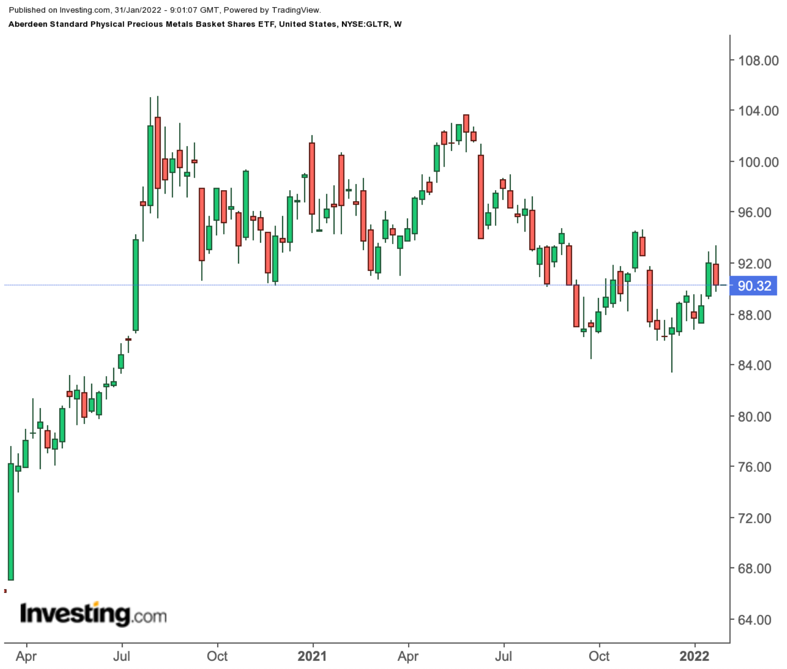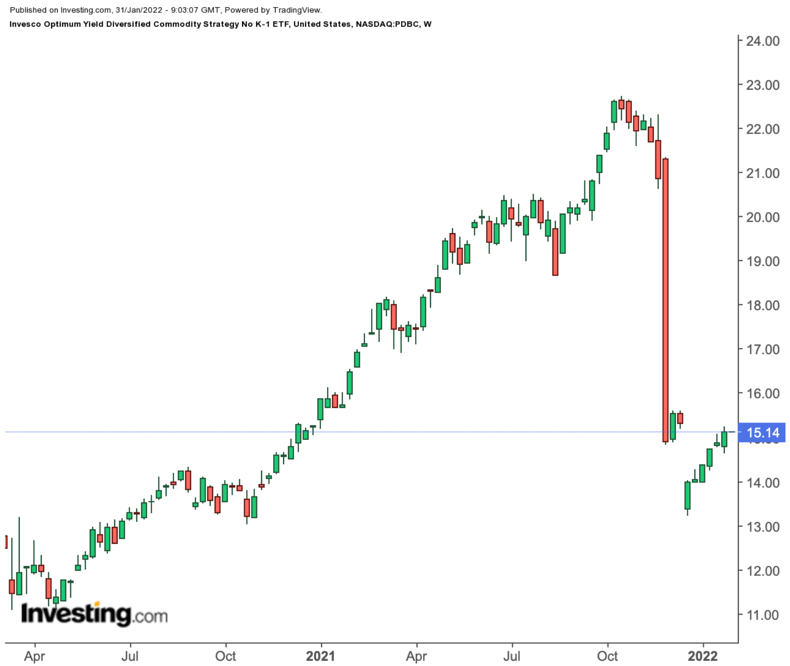Risk-off conditions, including increasing inflation, put broader markets on edge in January. The S&P 500 and NASDAQ 100 indices have turned lower and lost 6.9% and 11.5% so far in the year.
Meanwhile, the latest FOMC statement issued by the Federal Reserve highlights that the central bank:
“...seeks to achieve maximum employment and inflation at the rate of 2% over the longer run… With inflation well above 2% and a strong labor market, the Committee expects it will soon be appropriate to raise the target range for the federal funds rate.”
As a result, many investors are looking to include commodities in their portfolios. They could potentially outperform, especially high-growth shares such as many tech names. Therefore, today’s article introduces two exchange traded funds (ETFs) that focus on different commodities.
Long-term commodity price moves mostly depend on the interplay of supply and demand. Yet, we should remind readers that short-run price swings in most commodities tend to be wide. Thus, only a small allocation in a long-term portfolio is possibly more appropriate for most retail investors.
1. Aberdeen Standard Physical Precious Metals Basket Shares ETF
- Current Price: $90.32
- 52-Week Range: $83.38 - $103.61
- Expense Ratio: 0.60% per year
The Aberdeen Standard Physical Precious Metals Basket Shares ETF (NYSE:GLTR) provides exposure to four different precious metals, namely gold, silver, platinum, palladium. The fund was first listed in October 2010.
As of Dec. 31, 2021, GLTR held 762 bars of gold, 579 bars of palladium, 305 bars of platinum and 11,502 bars of silver. The fund keeps these metals in allocated bars at London-based vaults of JP Morgan.
On the same date, the fund's net assets stood shy of $1 billion, or at $966,575,374.04. In terms of allocation, gold had the highest weighting ($551,624,870.94 at $1,805.2/oz). Next came silver ($255,293,418.85 at $22.765/oz), then palladium ($120,556,919.42 at $1,973/oz), and platinum ($39,100,164.83 at $959/oz).
The diversified approach of GLTR could appeal to precious metal bulls, especially those who expect higher prices in gold as well as silver. Rising inflation would typically be bullish for these metals. However, higher interest rates and a potentially higher Dollar Index generally mean headwinds.
Regular followers of commodities would know that these four metals did not have a good year in 2021, whereas they all glittered in 2020. For instance, gold hit a record high of $2,050 per ounce in August 2020.
But since then, we have mostly seen lower highs and lower lows, and gold currently hovers at $1,790. Recently, the price has been consolidating. Those investors who forecast a gold price of over $1,800 in the months ahead could consider adding GLTR to their portfolios around these levels.
So far in the year, the fund is up almost 1.0%, but still down 6.4% over the past 52 weeks.
2. Invesco Optimum Yield Diversified Commodity Strategy No K-1 ETF
- Current Price: $15.14
- 52-Week Range: $13.22 - $22.73
- Expense Ratio: 0.68% per year
Our next fund, the Invesco Optimum Yield Diversified Commodity Strategy No K-1 ETF (NASDAQ:PDBC), gives access to several commodities by investing mainly in commodity-linked futures. Since its inception in November 2014, assets under management have reached $5.6 billion.
PDBC is an actively-traded ETF that aims to exceed returns of the DBIQ Optimum Yield Diversified Commodity Index Excess Return benchmark. A closer inspection of the index shows it comprises commodities across agriculture, energy, industrial metals and precious metals.
Among the leading commodities in PDBC are gasoline, NY Harbor ULSD, Brent crude, WTI crude, aluminum, zinc, copper, gold, soybeans, and natural gas. These ten holdings make up over 35% of the fund.
Year-to-date, PDBC returned more than 7.6%, and hit a multi-year high earlier in October 2021. But, since then it has come under pressure and lost close to 3.9% in the past 12 months.
Making sense of choppy markets can at times feel overwhelming for retail investors. Nonetheless, holding different asset classes could help decrease the volatility of a long-term portfolio. Therefore, we believe PDBC deserves further due diligence.
